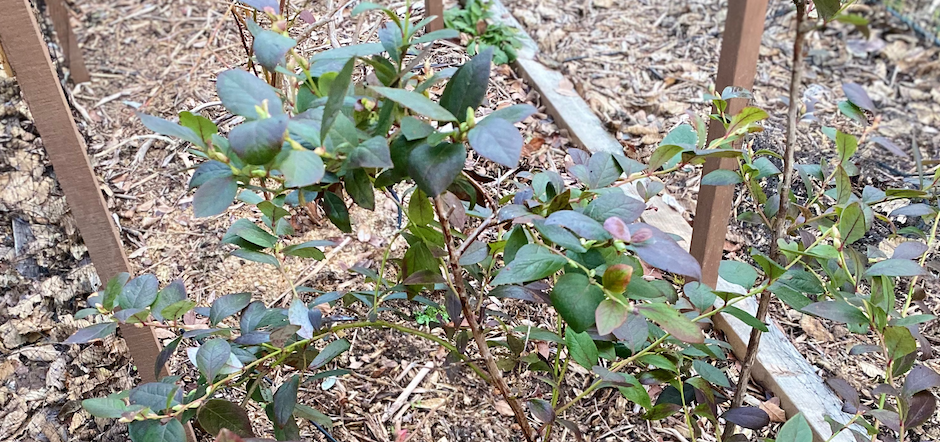by Doug Van Allen •
As February rolls around, my thoughts turn to prepping our blueberry plants for a successful growing season.
Before getting into the management tasks, a review of blueberry needs may be helpful.
- Blueberries grow best in fertile, well-drained soil with a ph of 4–5.5 (elemental sulfur can be used to lower pH)
- Being shallow rooted, blueberries don’t like any competition for water or nutrients. Keep all grass and other plants away from the bushes (at least a couple of feet beyond the drip line).
- For Northern Highbush varieties (the most common type in Western Washington), spacing should be five to seven feet (seven feet is best).
- To thrive, blueberries should get the equivalent of an inch/week of water during the growing season. Ideally, water should be applied by hand watering, soaker hoses or drip tape. That said, I watered my patch with an oscillating sprinkler for several years with no adverse effects.
- Annual pruning, fertilizing and mulching is recommended.
- Full sun is ideal.
Pruning
First up on the to-do list: since blueberries are shallow rooted (most of their roots are in the top six inches of soil), it’s important to keep the area around the plants weed free by gently removing all weeds and plants to an area one to two feet beyond the drip line.
Next up is February pruning. For younger /smaller plants, very little pruning may be necessary beyond cutting out dead, crossing and diseased branches along with any “twiggy” growth.
For larger plants, the same dead, diseased, crossing and twiggy guidelines apply. In addition, cut out branches that grow towards the center of the plant and possibly head back the plant if it’s getting too tall.
Next, consider thinning some of the older canes that are in the .75- to one inch-diameter size. Blueberries grow fruit on the tips of last year’s wood (laterals) that are coming off of two year or older canes. Production declines up to about eight years, at which point it may not be worth it to keep the canes. A mature clump of canes should be a mix of six to 12 newer and older canes.
When canes are cut, they should be cut at ground level. When branches are thinned, make the cut at a junction with another branch or cane. A good pruning guideline is to not remove more than 30 percent of a bush (not including dead wood). The good news is that blueberries are pretty forgiving regarding pruning.
Fertilizing and mulching
To keep this simple, I’d recommend using an organic rhododendron and azalea food (typically around a 4–5-3 NPK). On smaller plants, spread a cup of fertilizer around the plant out to the drip line and gently scratch it in. This should be repeated two more times on a monthly basis starting in March. Larger established bushes could use two to three cups for two to three months. The ideal growth of branches during a season should be in the six to 12 inches of growth range.
Mulching is super important with the possibility of using a number of different materials. Many commercial growers use sawdust because it’s cheap and consistent. Other materials could be wood chips, hog fuel, leaves and my favorite, shredded fir and hemlock bark. Note: If using sawdust be sure to add a little extra fertilizer to counteract sawdust’s hunger for nitrogen. Curiously, compost is not recommended due the fact that most compost has a pH of 6.5 to 7.5, which is too high for blueberries.
A system I use for laying down mulch is to do the March feeding of fertilizer (scratched in) first, then mulch around the plants two to three inches thick. Subsequent feedings are scratched into the mulch and then watered in.
With these steps, you’re on your way to a productive blueberry patch. Observing what happens with the plants is the best way to customize/adjust their care. Don’t forget to water!
GROWING SMALL FRUITS IN THE HOME GARDEN is great free publication from WSU Extension that covers blueberries as well as other small fruits. http://pubs.cahnrs.wsu.edu/wp-content/uploads/sites/2/2016/04/em103e.pdf
Here’s to much success in your garden!
Doug Van Allen is a WSU Extension Master Gardener in Jefferson County and has been growing blueberries and other small fruits for more than 25 years.


